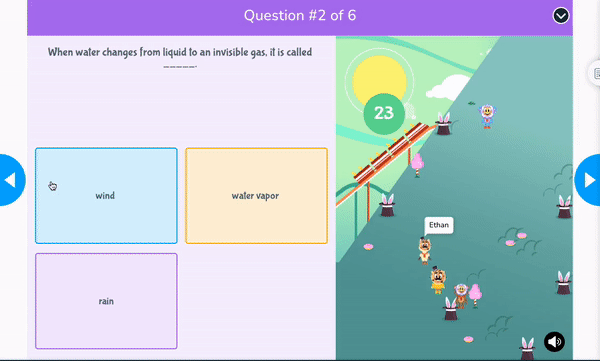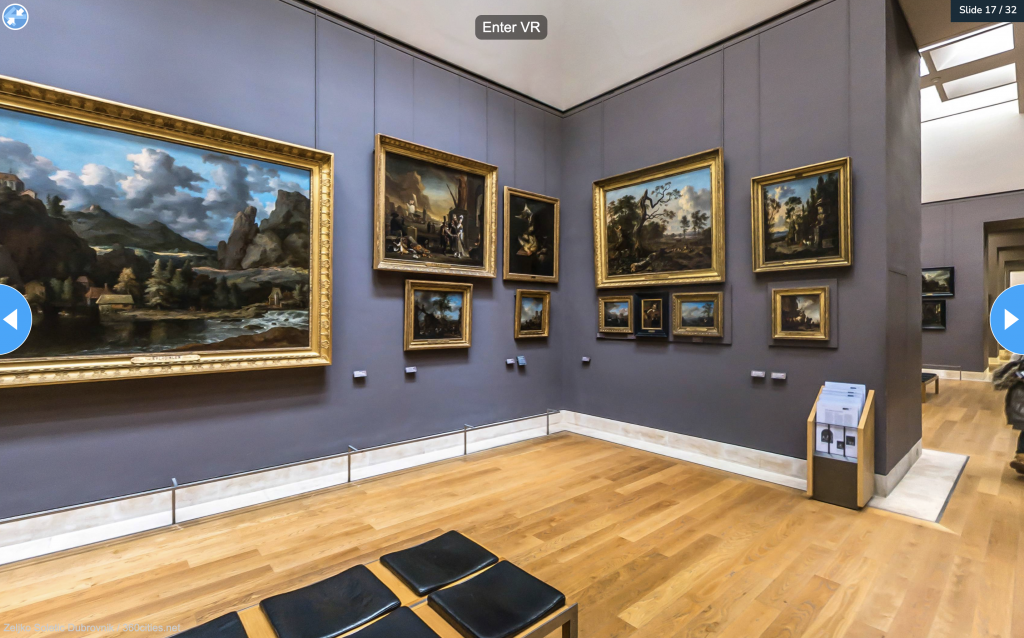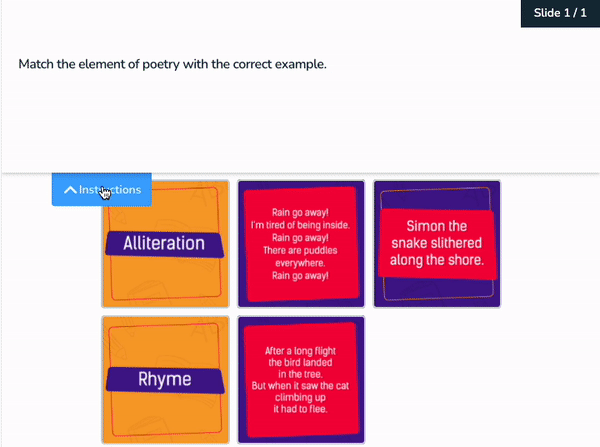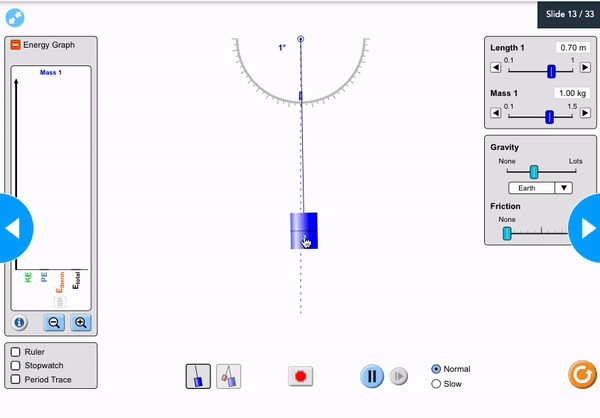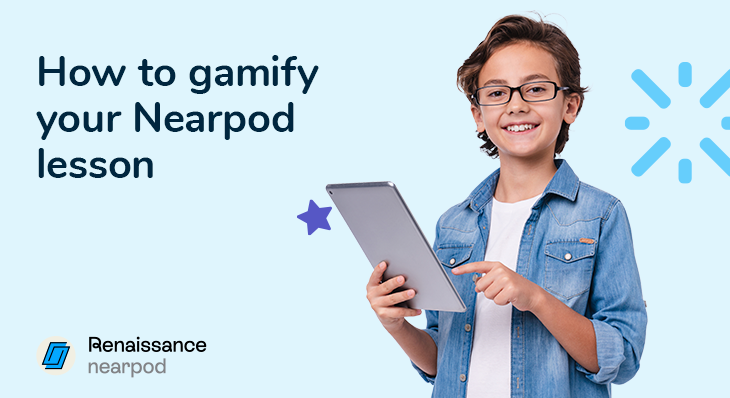
How to gamify your Nearpod lesson
This blog post is from a Camp Engage session, a free virtual professional development event for educators looking for new ideas, resources, and content to support their teaching.
Remember the excitement you felt as a child when playing your favorite game? That same energy can transform your classroom when you apply gamification to your teaching. Gamifying lessons taps into students’ natural love of play, competition, and achievement, creating an environment where learning becomes an adventure rather than a chore.
What is gamification in education?
Gamification is the practice of applying game-like elements to other activities. By incorporating gamification into teaching, you can make learning more fun and engaging for your students.
When thoughtfully integrated into lessons, gamification transforms passive learning into active participation—think of it as borrowing the best parts of games and weaving them into your curriculum!
The core elements that make gamification so effective include:
- Points systems that reward progress
- Team-based challenges that foster collaboration
- Healthy competition that drives engagement
- Time constraints that create urgency
- Meaningful challenges that push students to grow
- Leaderboards that celebrate achievement
Gamification can deliver impressive results in the classroom, as it can lead to enhanced motivation and participation and develop stronger teamwork and problem-solving skills, all of which can improve student academic performance. Perhaps most importantly, gamification helps cultivate positive attitudes towards learning, turning reluctant learners into eager participants.
This is where Nearpod gamification becomes your secret weapon. Nearpod is a powerful platform that seamlessly integrates these game elements into your lessons without requiring extensive technical knowledge or preparation time. Keep reading to learn how to design games using Nearpod activities!
New to Nearpod? Teachers can sign up for free below to access these resources, interactive activities, and engaging lessons. Administrators can schedule a call with an expert to unlock the full power of Nearpod for schools and districts.
How to gamify your Nearpod lesson
1. Time to Climb
Wondering how to create a game in Nearpod? Look no further than Time to Climb. The Time to Climb game turns traditional quizzes into thrilling mountain-climbing adventures where students race against time and each other to reach the summit. This Nearpod feature combines the excitement of competition with the satisfaction of immediate feedback, creating an experience that students genuinely look forward to.
The beauty of Time to Climb lies in its versatility for formative assessment and review. Use it at the beginning of a lesson to check prior knowledge, then deploy the same quiz at the end to demonstrate student growth. Students can literally see their improvement as they climb higher and faster on their second attempt. This visual representation of progress is incredibly motivating and helps students take ownership of their learning journey.
For maximum impact, consider using Time to Climb as a formative assessment tool throughout your unit. Create your own quizzes, or use AI Create, and watch as students eagerly participate in what they perceive as gaming rather than a test of their knowledge. The competitive element of Time to Climb naturally encourages students to review material and come prepared, while the immediate feedback helps you identify areas that need additional attention for the whole class or a particular student.
2. Virtual Reality Field Trips
Nearpod’s Virtual Reality (VR) Field Trips transform your classroom into a portal to anywhere in the world (or beyond!). This feature combines immersive 360-degree experiences that make exploration educational and exciting.
You can turn virtual exploration into point-based treasure hunts by awarding points for keen observations and detailed descriptions. Challenge students to identify specific numbers of nouns, adjectives, or complete sentences that describe what they see. Create “I spy” games where students hunt for shapes, colors, architectural features, or modes of transportation, and give them points for each correct identification.
The collaborative potential is enormous. Try dividing students into teams and have them compete to describe people, places, and objects with the most accuracy and creativity. Whether you’re exploring ancient Rome for history class, diving into coral reefs for science, or touring art museums for English, VR Field Trips provide authentic contexts that make abstract concepts tangible and memorable.
3. Draw It
Draw It is where creativity meets curriculum. This feature turns drawing into a competitive, collaborative, and highly engaging learning experience that appeals to visual learners and reluctant participants alike.
Set up Pictionary-style competitions where students must draw vocabulary words, scientific concepts, or historical events while their teammates try to guess what the drawing is depicting. This approach works well for language learning, where students can practice new vocabulary through visual representation, or in science classes, where students can draw molecular structures or biological processes.
For collaborative projects, use Draw It to create shared visual stories or solve problems together. Students can follow sight word mazes by drawing paths, create mystery pictures by following specific instructions, or work in teams to illustrate complex processes step by step.
4. Interactive Videos
Nearpod’s Interactive Videos feature gamify passive watching by embedding activities directly into the viewing experience. This transforms traditional video lessons into dynamic, participatory adventures where students can engage in real-time problem-solving.
Create quiz battles by adding strategic questions throughout videos, with students or teams earning points for correct answers. Use one device per team to encourage collaboration and discussion before answering. This approach works well for flipped classroom models, with students watching videos as homework and working on comprehension during class time.
Design scavenger hunts within videos by embedding questions that require students to find specific information, solve problems, or make predictions about what comes next. Partner students together to watch videos, fostering discussion and deeper comprehension as they work together to answer embedded questions. The gamified nature keeps students alert and engaged throughout the entire video, eliminating the passive consumption that often leads to wandering attention.
5. Matching Pairs
Matching Pairs transforms traditional flashcard activities into fast-paced, competitive games that help students master vocabulary, concepts, and connections through repeated practice that doesn’t feel repetitive.
The applications are limitless across subjects. Language teachers can match vocabulary words to definitions, Spanish words to English translations, or vocabulary to images. Or science educators can connect scientific terms to diagrams, math teachers can pair equations with solutions, and social studies teachers can match countries to flags, landmarks, or capitals. The game-like interface reduces anxiety often associated with traditional memorization activities, while the immediate feedback and competitive timing make practice sessions fun for students.
Try creating tournament-style matching competitions where students advance through increasingly difficult levels or use it as a warm-up activity that reviews previous lessons while introducing new content.
6. PhET simulation
PhET simulations bring hands-on laboratory experiences into any classroom, complete with different difficulty levels, achievement rewards, and instant feedback that make complex concepts accessible and engaging. These interactive simulations transform abstract scientific and mathematical concepts into hands-on experiences.
Students can experiment with physics concepts like gravity and motion, explore chemical reactions safely, or manipulate mathematical variables to see real-time results. The trial-and-error nature encourages scientific thinking while the game-like interface maintains engagement.
Use PhET simulations to create classroom competitions where teams race to solve problems, reach specific outcomes, or explain phenomena they observe. The interactive nature of these simulations means students learn through discovery rather than memorization, making them a prime example of how Nearpod immerses students in their learning.
Start using Nearpod today!
Gamifying your Nearpod lessons isn’t about turning education into entertainment—it’s about harnessing the natural motivators that make games compelling to create meaningful learning experiences. Start with just one of these six strategies that aligns with your current teaching goals. Whether you choose the competitive excitement of Time to Climb, the immersive exploration of VR field trips, the creativity of Draw It, or any of the others, you’ll quickly see how gamification transforms not just student engagement, but your own teaching satisfaction.
New to Nearpod? Teachers can sign up for free below to access these resources, interactive activities, and engaging lessons. Administrators can schedule a call with an expert to unlock the full power of Nearpod for schools and districts.

Natalie is an educator with over 10 years of experience, including 5 years as a special education teacher. She now teaches online, bringing energy and creativity to every lesson through the power of games and educational technology. Passionate about making learning fun, Natalie helps students stay engaged, excited, and eager to learn while having fun and helps other teachers do the same.
